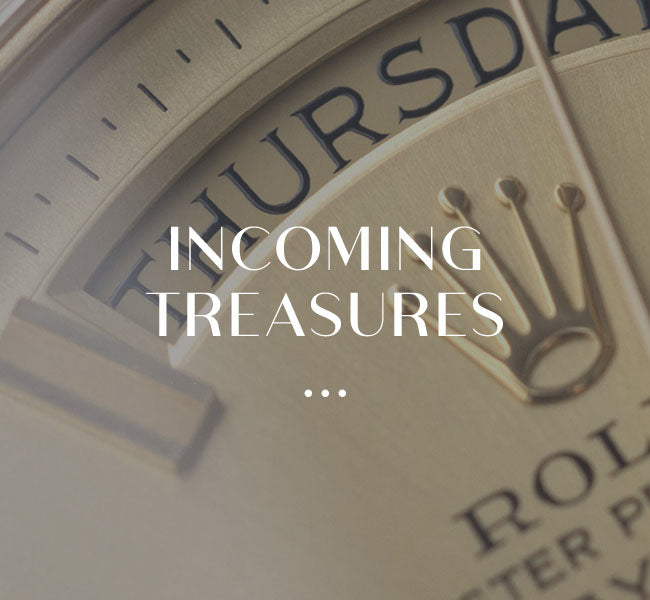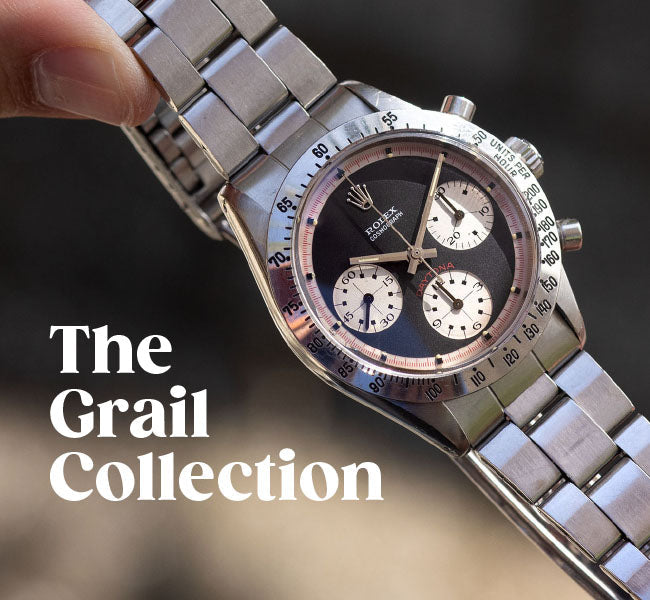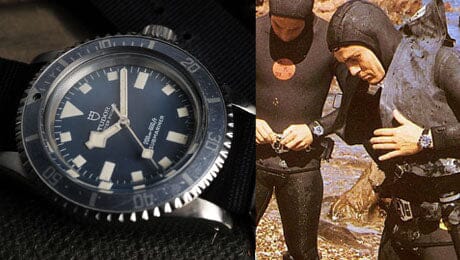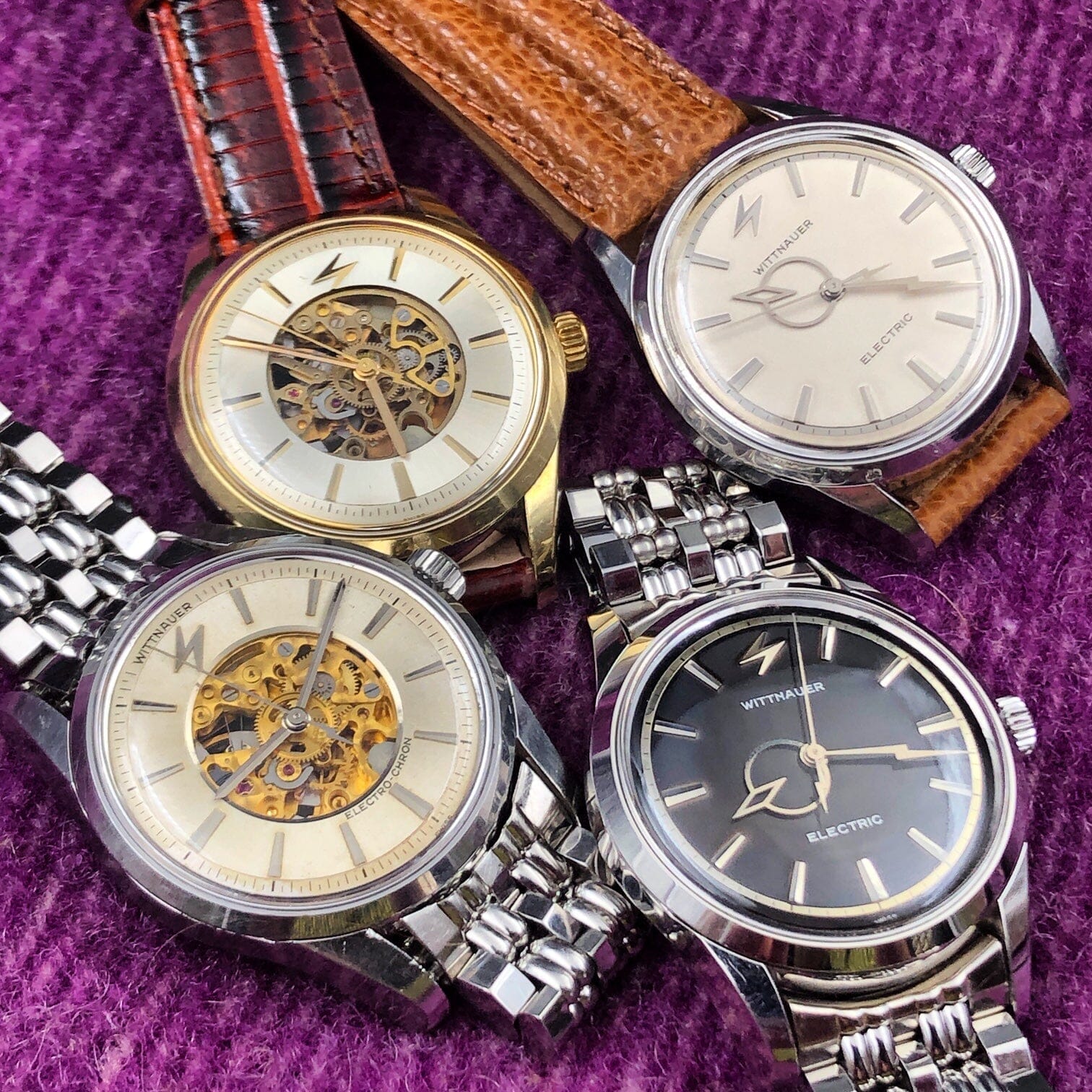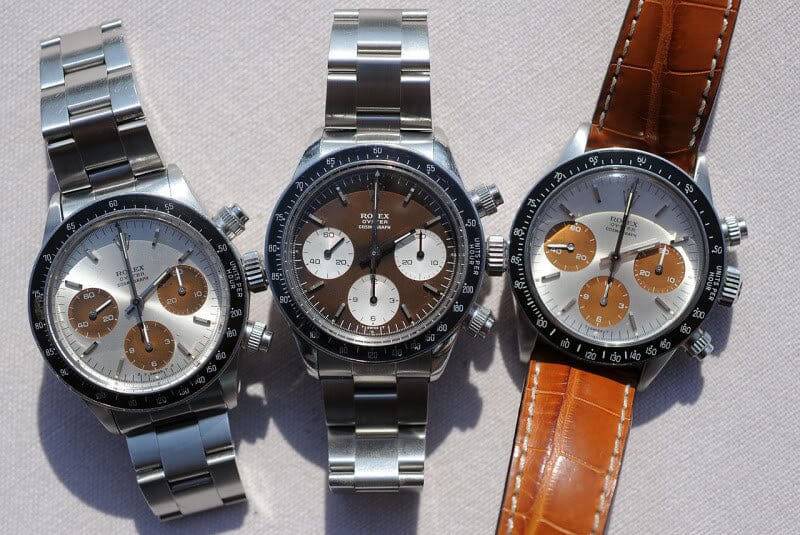
Rolex Daytona – Seven Decades of The Cosmograph
World record auction prices, decade-long waiting lists and one of the most loyal and dedicated sub-sections of collectors – we must be talking about the Rolex Daytona. One of the most iconic chronographs ever produced, the Cosmograph Daytona is in its seventh decade of production and is arguably still one of the hottest watches in the market for both vintage and modern watch collectors. Even if you don’t collect watches, the chances are you would love a Rolex Daytona. Today we take a tour through the chrono’s landmark moments over the last 67 years and share some of our favourites from the Bulang and Sons archive as well as some that we currently have in our shop.
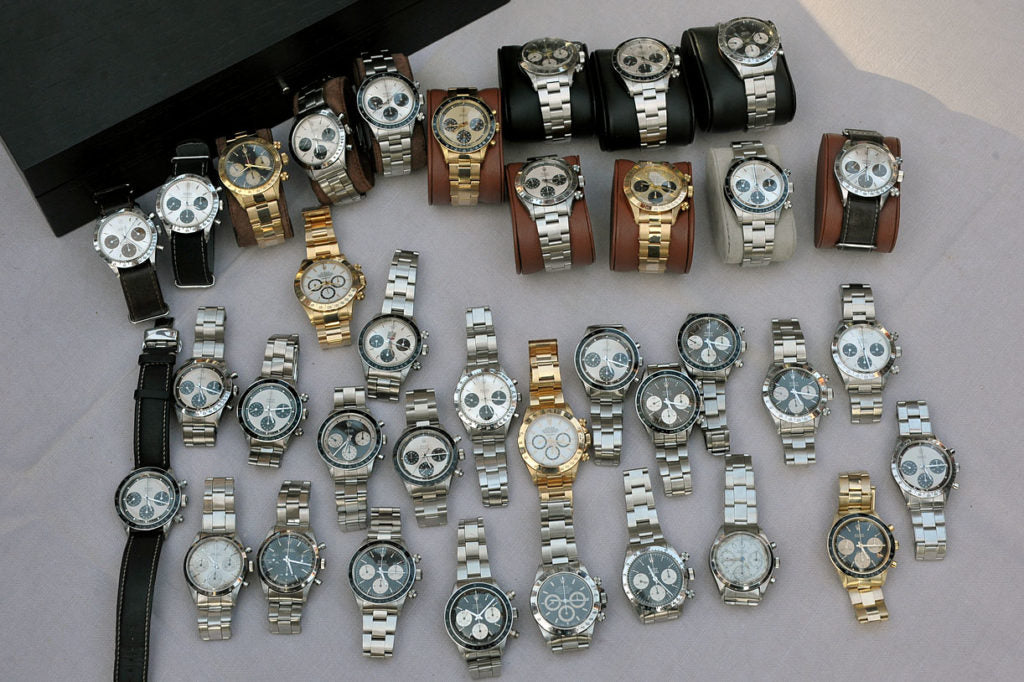
1960s Birth of An Icon
The Rolex chronograph has been around since the 1930s and in the 1950s Oyster cased models began emerging. The first true racing chronograph appeared at the very beginning of the 1960s in reference 6238. A 36mm, three register chronograph, the reference 6238 is known as the Pre-Daytona due to its uncanny resemblance to what would come a few years later. That day came in 1963 with the unveiling of the reference 6239 Cosmograph Daytona.

The main difference between this and previous Oyster chronographs was the presence of a tachymeter bezel, which replaced the dial-based tachymeter that had been in use for the decades before. The steel bezel had engravings with black enamel in-fill that could be used to measure speeds through the centre stopwatch hand, which was operated via a ‘start/stop’ upper pusher and ‘reset’ lower pusher.

The pushers on these watches collectors refer to as ‘pump pushers’, as they didn’t have the screw down feature that came in later models. The 6239 was the first time a chronograph appeared with contrasting or inversed sub registers. There were initially two options – black dials with white sub dials or silver dials with black sub dials. Rolex experimented through the entire life of the Daytona with dial variations, however a number of different versions were seen during the seven years of production that the 6239 enjoyed.

The earliest dials from the first year of production were marked SWISS only (or twice in the super collectible ‘Double Swiss’ watches) and in around 1964 the marking T SWISS T appeared. In 1966 Rolex introduced the reference 6241, which was essentially the same as the reference 6239 but with a black plastic tachymeter bezel. The pump pusher Daytona have a softer presence on the wrist and feel more dressy and less ‘sporty’ on the wrist. This is also largely due to the diminutive 600 series, 6mm screw down crown.
In 1965 there was a huge technological breakthrough in terms of the watch’s waterproof capabilities. The reference 6240 was introduced, featuring screw down pushers, a feature that is still very much alive today in the Daytona. Wilsdorf’s Oyster case relied on the screw down winding crown, screw case back and pressure-fit crystal with retaining ring/bezel. The pump pushers compromised this waterproof integrity and so one can imagine that a waterproof solution to the pusher problem was a key priority for the brand. The first screw down Oyster pushers had very fine knurling and has the nickname ‘millerighe’.

Without wanting to jump straight into the next decade, we need to dip or toes in to quickly mention two pump-pusher transitional references – 6262 (steel bezel) and 6264 (plastic bezel). These two references featured Rolex’s improved calibre 727 movement and were available from 1970 to early 1971/72.
Named Exotic
It would be impossible to discuss the 1960s Daytonas without some reference to the exotic dials that were available across the references. The dials continue the theme of contrasting dial and sub dial schemes but with the addition of a contrasting chapter ring (black ring on white dials and vice versa) with, in some cases, red seconds and sub-second markings on said chapter ring.

The sub dials also featured more ‘exotic’ number fonts and square lollipop-esque markings on the sub dials. The nickname of the dial came after the famous movie star Paul who was seen wearing an exotic dial 6239 on the promotional picture for one of his movies. History was made in 2017 when his watch sold at Phillips New York for a staggering $17.8M!


1970s Screw It!
In 1971 Rolex launched what would come the most well-known and longest running iteration of the manual wind Daytonas – references 6263 (plastic bezel) and 6265 (metal bezel). The screw down Oyster pushers were now well established and the watch settled on calibre 727 as seen in references 6262 and 6264. As with reference 6240, the 6263/65 were fitted with larger 700 series, 7mm screw down crowns. This subtle change makes a big difference on the wrist, with the chronograph now sharing the same winding crown as the Submariner and Seadweller. There are many collectible versions of these watches, including the fantastic Big Eyes.

Due to the more robust nature of the Daytona, it was used in a number of military environments including the Peruvian Air Force – the Fuerza Aerea del Peru (FAP). As Bernhard has written in the past, the relationship between Rolex and the FAP is believed to have been due to the close friendship between the official Rolex dealer of Lima, and the late Andre Heineger, the father of Patrick Heineger; both of whom were CEOs of Rolex (Andre succeeded Hans Wilsdorf as CEO in 1962). The Fuerza Aerea Del Peru Cosmographs are often found with the following characteristics:
- Dials from 6239 to 6263/5 usually without the word ‘Daytona’
- Outer caseback engraved with Fuerza Aerea Del Peru (engraved by Rolex, who have a record of the issue numbers) and very lightly engraved delivery numbers (often erased via polishing as with the early Comex 5513/4)
- Inner case backs with specific corresponding serial engravings

archive

A long tradition of giving gifts in Middle East exists, especially from its rulers to senior members of their armed forces. Rolex watches made the perfect gift, especially from the Sultan of Oman who was himself a very keen watch collector. Amongst a number of Rolex models that were given as gifts, some of the most sought after are Daytonas, especially examples from the 70s and early 80s in reference 6263 or 6265. The most collectible are those versions where the Khanjar logo replaces the text in the upper halkf of the dial, leaving the applied coronet and the DAYTONA about the hour sub dial.


1980s: Perpetually Daytona
Maybe it was due to its long lifespan or maybe tastes had changed and the Cosmograph hadn’t, but y the mid-80s the 36mm manually wound Daytona had fallen out of favour. Even buyers of pre-owned Rolex watches had footnotes on their buying ads asking potential sellers “not to bother offering Daytonas” and dealers found themselves stuck with the watches for months and even years! But the model’s fortunes changed drastically in 1988 when a newly reworked and revamped version of the Daytona was unleashed upon an unsuspecting Basel Fair.

This was a true reinvention and yet the designers at Rolex kept the Daytona’s DNA perfectly intact in the revamped version. So much is spoken of Gerald Genta as being one of the most important watch designers of the 20th century, a statement that we fully agree with. But the brain behind the new Daytona from 1988 also deserves a huge amount of credit for reshaping one of the most iconic watches ever. The case grew to 40mm and now included crown guards to flank the winding crown. Gone too was the domed plexi crystal and in its place a scratch resistant sapphire one. The biggest difference was, however, the fact that the watch was now automatic thanks to a modified Zenith El-Primero movement.

We love these watches at Bulang and Sons, especially early rare examples such as the very first models that had a glossy finish, so-called porcelain, with what collectors refer to as a ‘floating’ dial. This name comes from the fact that the fifth line of text in the upper half, COSMOGRAPH, is detatched from the rest of the text and appears to be floating away.

Equally rare is the second version of the dial that uniquely, only had four lines of text in the upper half. Each of these versions of dial had their own bezel types too – link on the links to learn more!



1990s The Stones
In the 1990s Rolex began in earnest to turn its gem-setting attention to the Daytona. The worlds of haute-jewellery and horology collided and the resulting watches are now becoming ever more sought out by collectors. The dials in Daytonas became ever more important, with hard stone examples being offered in sodalite, grossular garnet and mother of pearl. The manufacturing processes involved in making these dials is very labour intensive, with very high fail rates. Each piece of stone has to be worked on until it is a fraction of brittle stone that is then applied to a brass dial base. Often, these dials then had diamond hour markers affixed.


The 1990s also saw the introduction of white and yellow gold watches with fixed endlinks and leather straps. These watches were often fitted with interesting dials, as mentioned above, and were also available with gem set bezels. This tradition has remained in place with the Rainbow Daytonas of recent years being highly prized not just by Rolex collectors, but all those who appreciate high quality and different wristwatches. Special order pieces were also possible to VIP clients, a number of which have come to market in recent years including platinum examples and unique stone set pieces.



2000s An In-House Movement
Rolex is one of the most committed brands when it comes to research and development and making sure that every little detail is perfect in its watches. In terms of ensuring that they maintain complete control, I can imagine that having to rely on another brand’s movement to drive what became their flagship sports watch. In 2000 the brand was able to move away from the modified Zenith movement and replace it with their new in-house movement the calibre 4130. This movement meant that the Daytona had some subtle changes including the two sub dials moving a fraction higher on the dial to allow for the new movement. Gem-setting was also still a key aspect of the Daytona, with maybe one of the wildest creations being unveiled in 2004 – the 116598SACO AKA The Leopard!

The Zenith-era Daytonas (1988 to 2000) were always credited as being the last of the Rolex watches that had accepted variations in dials – what collectors refer to as marks. In the case of the 16520, there are nine versions of dial. However, over the past few years, collectors and scholars have begun the collation of different versions of the 116520 dials. The two best known versions are the so-called ‘Panna’ and ‘APH’ dials. The ‘Panna’ dials are named after the creamy Italian pudding pannacotta and reference the fact that early models with white dials from 2000 and 2001 (P and K serials) have turned a noticeable cream colour. The ‘APH’ dial got it’s nickname due to the noticeable gap in the word COSMOGRAPH between the ‘R’ and the ‘A’. These dials appeared in the last four years of the 116520’s run.


2010s Ceramic Fantastic
In 2011 Rolex introduced the Everose gold Daytona reference 116515, on leather strap, that was the first Daytona to feature a ceramic bezel. The ceramic bezel featured the same graphics and fonts as the yellow and white gold bezels that had appeared on Zenith-era strap-only watches. This font would continue to be the norm for all ceramic Daytona bezels into the future.

2013 marked the 50th anniversary of the Rolex Daytona and to celebrate this incredible milestone, Rolex unveiled a platinum version reference 116506. The watch featured a glacier blue dial, a colour also seen in platinum Day-Dates, and the watch was finished with a somewhat unusual brown ceramic bezel. The brown bezel complimented the brown chapter rings on the dial and the whole look of the watch was as eye-catching as it was unusual. In 2016, Rolex unveiled what people had been waiting years to see – a new steel Daytona with ceramic bezel. Sticking to the formula, the watch was available with either a black or a white dial. And guess what…the waiting lists are still as long as ever!

2020s Who Knows…
We’re only six months into the 20s…I know that seems hard to believe after the ear we have all experienced. Will Rolex even release new watches this year? Who knows! There have been rumours of a new Daytona, but then there is every year. What we can be sure of is that the Daytona continues to be one of the hottest watches on the market right now. Vintage or modern, classic or gem set – whatever your poison, there’s a killer Rolex Daytona for you!




